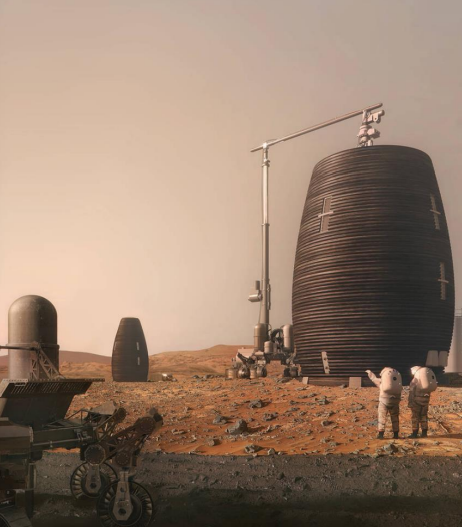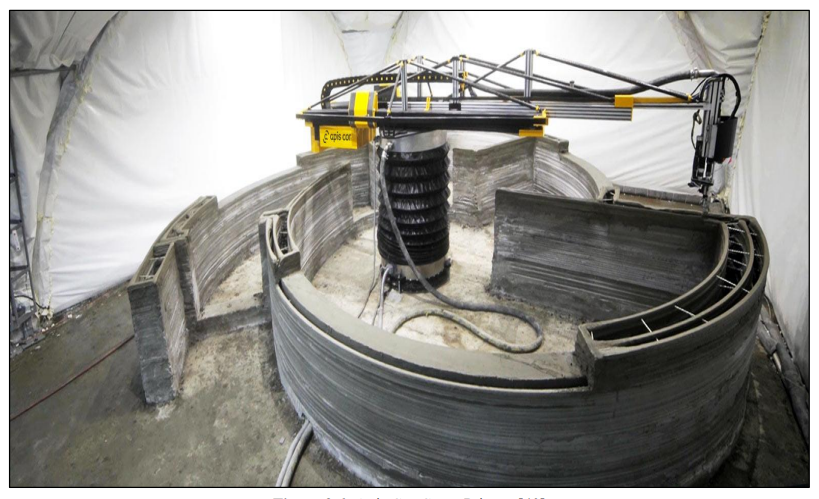Andrew Truong recently presented a thesis, ‘State-of-the-Art Review on 3D Printing Technology Applications in Construction,’ to the University of California, Irvine. Reviewing 3D printing in construction, Truong tackles a multi-faceted topic regarding materials, technique, and the future of the industry—even going as far as discussing the potential for construction on Mars.
Today industrial users may be experimenting with new modes of production, different composites, or working on a larger scale with concrete, but while so many benefits are available, challenges still remain too. This leaves researchers a lot of room for discussion and experimentation, and especially as new projects with different requirements arise.
Truong takes his readers on a short foray through the history and emergence of 3D printing in the mainstream, noting especially its impacts on applications within medicine, the emergence of RepRap Open Source and Makerbot, and the growing popularity of FDM 3D printing overall. With the opportunity for making big headlines, numerous companies have built homes, touting record speed, and huge potential for economic residences in the future.
“In the construction industry, 3D printing is used to manufacture structures with nearly zero waste, minimum costs, and faster building time. Within days, depending on the complexity and size of building, a new structure can be built that can be customized for each building iteration,” explains Truong. “Houses built using 3D printing technology can be achieved by a variety of ways and each method of construction has its advantage and disadvantages.”

3D concrete printer in operation. No-slump concrete leaves the nozzle as a relatively stiff continuous filament. [23]
Typical materials used are:“The high resolution of the printing makes it able to print thin layers that are refined to have a finish exterior on the print. This nozzle houses the extrusion screw auger motor that pumps out the concrete before it is place on the 3D print,” states Truong.
“The printer then moves in the direction and orientation of the printer to accurately 3D print the object. Therefore, the extrusion system has two motors. One motor is used to dispense the concrete out of the nozzle. The other motor is used to orient the nozzle in the correct direction. The shape of this nozzle creates a fine layer instead of a glob bead. The fine layer creates way for the 3D printer to have fine resolution prints in the same way a thermoplastic 3D printer works with a different print material and nozzle extruder.”
- Thermoplastics
- Photopolymers
- Concrete
- Mortar
The use of formworks in construction can lead to longer time in production, more waste of materials, and greater expense; with more streamlined techniques avoiding the need for frameworks, industrial users experience more latitude in design and actual ‘building.’ In constructing homes, no formworks are required.
“Doors and windows are built by placing a beam across the overhead gap while 3D printing or modular piece by piece construction is used,” said Truong. “After the house walls are 3D printed, the roof is then built to complete the structure. Mechanical, electrical, and plumbing can then be surface mounted to the structure. The exterior design of the house can be a layering pattern due to 3D printing or finish grout can be applied to create a smooth surface indistinguishable from traditional concrete building methods.”
Equipment can be and is routinely modified by engineers developing projects for different applications.
Structures have been constructed by companies like WinSun, Total Kustom, Apis Cor, and WASP.Touching on construction in space, Truong reminds us of the need to arrive at the destination with cargo as light as possible—but with the potential to build using designs created on 3D printers and material mined from the site, such as regolith from Mars.“Since Mars is covered with a regolith that can be used for in-situ construction, building on Mars is also economically feasible. 3D printing is an emerging field in construction that builds concrete formwork layer by layer without the use of molds nor forms. The feedstock used in 3D printing concrete requires a mix design that uses fine particles, because the feedstock must have a viscosity and workability that is able to flow through an extrusion and dynamic pump system,” states Truong.
“The concrete mix will be 3D printable based on buildable layers, flowability through the system, and low gravitational out gassing [55]. The material properties of the mix design should also be structural enough to be used as radiation shielding and resilient to brittle cracking which induces a loss of cabin pressure in order be used in the Martian environment.”
The author goes into numerous designs created for Mars habitat challenges, yielding extremely interesting results.

Team AI. SpaceFactory of New York is the second-place winner in NASA’s 3D-Printed Habitat Challenge, Phase 3: Level 1 competition. [49]

Team Kahn-Yates from Jackson, Mississippi, won third place in Phase 3: Level 1 of NASA’s 3D-Printed Habitat Challenge. The team virtually designed a Mars habitat specifically suited to withstand dust storms and harsh climates on the red planet. [50]
“Research and development into the range of applications of 3D printing in construction is the beginning of a new building industry standard. The development of multistory construction will further increase market viability. While automated reinforcement, mechanical, electrical, and plumbing will increase construction speed and architectural design. The development of 3D printing thermoplastics with timber composites will make 3D printed houses competitive with suburban houses because homeowners will be able to hang picture frames and cabinets without anchoring into concrete,” concluded the author.
“Prices for timber 3D printing filament is like 3D printing thermoplastics, because of the lack of an industrialized method of manufacturing the timber filament. Since the filaments are 77 made of sawdust, the filament should be able to be manufactured at a lower price. Several develops in the 3D printing construction industry will lead to the ubiquity of 3D printing construction and infrastructural changes in construction will provide an efficient method of building.”
What do you think of this news? Let us know your thoughts! Join the discussion of this and other 3D printing topics at 3DPrintBoard.com.
[Source / Images: ‘State-of-the-Art Review on 3D Printing Technology Applications in Construction’]Subscribe to Our Email Newsletter
Stay up-to-date on all the latest news from the 3D printing industry and receive information and offers from third party vendors.
You May Also Like
3D Printing Financials: Fathom Struggles in Financial Quicksand During Critical Transition
Facing a year of key transitions and financial pressures, Fathom (Nasdaq: FTHM) has filed its annual report for 2023 with the U.S. Securities and Exchange Commission (SEC). The document outlines...
Latest Earnings Overview for Australian 3D Printing Firms Titomic and AML3D
Australian 3D printing manufacturing firms Titomic (ASX: TTT) and AML3D (ASX: AL3) reported their financial results for the period from July to December 2023, marking the first half of their...
3D Printing Webinar and Event Roundup: April 7, 2024
Webinars and events in the 3D printing industry are picking back up this week! Sea-Air-Space is coming to Maryland, and SAE International is sponsoring a 3D Systems webinar about 3D...
3D Printing Financials: Unpacking Farsoon and BLT’s 2023 Performance
In the Chinese 3D printing industry, two companies, Farsoon (SHA: 688433) and Bright Laser Technologies, or BLT (SHA: 688333), have recently unveiled their full-year earnings for 2023. Farsoon reported increases...





































